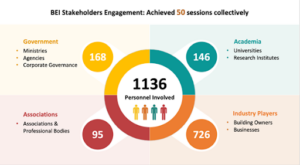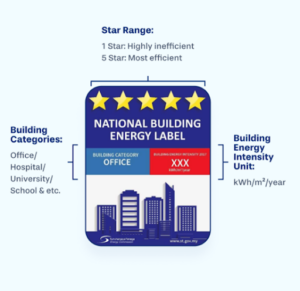Powering Sustainability
Building Energy Benchmarking For A Healthier Planet
by Prof. Ir. Ts. Dr. Zainuddin bin Abd Manan
& Dr Azlin Abd Jamil
As climate crises intensify, the need to protect our planet has never been more urgent. The concept of “planetary health” is a bold call to action, emphasizing that the health of humanity is inseparable from the health of the Earth. This paradigm seeks to strike a balance between development and sustainability, ensuring that future generations inherit a world that thrives. One area where this balance is crucial is in the building sector, which plays a significant role in mitigating climate challenges. Buildings are responsible for nearly 40% of global carbon emissions, with 28% coming from operational energy use—such as heating, cooling, and lighting—and 11% from the embodied carbon of the materials used in construction. Addressing this issue is key to reducing our collective carbon footprint and safeguarding planetary health for future generations.
The good news is that there are concrete steps we can take to reduce the environmental impact of buildings. Energy efficiency (EE) is one of the most effective strategies for tackling this challenge, and the introduction of energy labeling has proven to be a game changer in improving building performance. Energy labels, which measure how much energy a building consumes per square meter, provide a clear benchmark that helps building owners adopt smarter, more sustainable practices. Countries like the United States, the European Union, and Singapore have adopted these labels, reshaping real estate markets and encouraging investment in greener properties. High energy ratings have made buildings more attractive to both buyers and renters, who benefit from lower utility bills and a clear commitment to sustainability. These labels also promote a sense of shared responsibility, raising awareness among building owners and occupants about energy efficiency while ensuring that buildings comply with environmental standards.
At a time when the urgency of protecting our planet is growing, it’s essential to acknowledge that every action counts, even if the technicalities behind planetary health may not be widely known. Malaysia is taking bold steps to join the global effort to combat climate change and protect our environment. A significant part of this effort is improving energy efficiency, particularly in buildings, which are responsible for 49% of the nation’s electricity consumption and 12% of overall energy demand. With such a large impact, focusing on energy efficiency in buildings is a clear priority.
To address this, the Malaysian government is introducing the Energy Efficiency and Conservation Act (EECA), which will take effect in January 2025. This new legislation is designed to regulate energy use in buildings and factories that consume large amounts of energy each year. Under the EECA, these energy-intensive facilities will need to meet stricter efficiency standards, ensuring that they use energy more responsibly.
What’s particularly exciting is that the EECA also brings energy labeling into the spotlight for commercial buildings, targeting the 79% of energy consumption in this sector that remains unoptimized. By mandating energy labels for specific types of buildings, the government aims to make energy performance transparent and drive improvements throughout the industry. This is a major step toward creating a more energy-efficient future for Malaysia, contributing not only to the country’s sustainability goals but also to the global movement for a healthier planet.

50 sessions to directly engage over 1000 personnel from the government, industry, academia and associations.
Supporting these regulations is Malaysia’s ambitious Building Energy Intensity (BEI) Benchmarking Project, led by Universiti Teknologi Malaysia (UTM) and spearheaded by Prof. Ir. Ts. Dr. Zainuddin bin Abd Manan with Malaysian Association of Energy Services Companies (MAESCO) as the partner. The BEI project brings together government agencies, academia, industry leaders, and communities to transform the way energy is used in buildings. It is a collaborative effort, funded by the Malaysian Electricity Supply Industry Trust Account (MESITA) under the Kementerian Peralihan Tenaga dan Transformasi Air (PETRA), aimed at establishing clear standards, encouraging best practices, and inspiring sustainable energy use nationwide. At the heart of the BEI Benchmarking Project is measurement and accountability. BEI calculates the energy consumption of a building per square meter each year, effectively serving as its energy “report card.” A lower BEI score signifies better efficiency, leading to lower costs and reduced emissions. For building owners, this metric highlights areas where energy use can be optimized, enabling them to make informed decisions. For tenants and occupants, it offers transparency, showing whether the building meets energy-efficient standards.
This project evaluates energy performance across six key building types: offices, educational institutions, hotels, hospitals, data centers, and retail spaces. The Energy Commission will kick off the initiative with office buildings, with plans to expand to other categories over time. Each building will need to display an energy label, indicating its BEI, star rating, and type. Low-performing buildings, those with one star, will be required to undergo audits and develop plans to improve their energy efficiency.
Why does this matter? Beyond cost savings, energy labeling encourages competition among building owners to improve their ratings. This healthy rivalry sparks innovation and speeds up the adoption of green technologies across the industry. Additionally, it aligns with Malaysia’s commitment to cut greenhouse gas emissions intensity by 45% by 2030 and achieve carbon neutrality by 2050.
In less than a year, the BEI project has already made a significant impact. Over 50 engagement sessions have introduced more than 1,000 stakeholders—including government officials, industry representatives, and academics—to the concept of energy benchmarking. These efforts have raised awareness and prepared building owners for the upcoming energy labeling under the EECA.
One of the standout achievements of the project is the development of a Building Energy Rating (BER) system tailored to Malaysia’s unique needs and conditions. This system is set to become a benchmark not just nationally but also regionally, reflecting the power of collaboration and the shared commitment to energy efficiency.
Malaysia’s commitment to energy efficiency in buildings is more than just a regulatory change—it represents a bold step toward a more sustainable and resilient future. By embedding sustainability into its development strategies, Malaysia is not only shaping a greener tomorrow but also leading by example for other nations to follow. Through initiatives like energy labeling and the BEI Benchmarking project, Malaysia is showing that true progress lies in balancing development with the health of our planet. In doing so, the country is not merely addressing its own energy challenges but playing an essential role in the global effort to safeguard our environment for generations to come. As we face an uncertain future, Malaysia’s proactive approach offers hope—proof that even in the face of climate crises, there is still time to act, adapt, and create a legacy of sustainability.
Co-authors:
Prof. Ir Ts Dr Sharifah Rafidah Wan Alwi
Assoc. Prof. Ir Dr Lim Jeng Shiun
From MAESCO:
Mr Zaini Abdul Wahab
Mr Iskandar Majidi.
